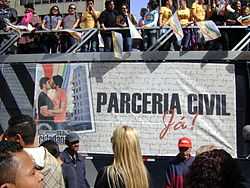São Paulo Gay Pride Parade
| São Paulo Gay Pride Parade | |
|---|---|
 São Paulo LGBT Pride Parade | |
| Date(s) | Sunday after the annual holiday of Corpus Christi |
| Frequency | Annually |
| Location(s) | São Paulo, Brazil |
| Inaugurated | June, 1997 |
| Most recent | May, 2013 |
| Participants | Over 5 million(2013) |
São Paulo LGBT Pride Parade (Portuguese: Parada do Orgulho LGBT de São Paulo) is an annual gay pride parade that happens in Avenida Paulista, in the city of São Paulo, Brazil, since 1997. In the year of 2006, it was considered the biggest pride parade of the world by the Guinness Book of World Records. In 2010, the city hall of São Paulo invested R$ 1 million reais in the parade. The event is the second largest of the city, after only Formula One.[1] According to the LGBT app Grindr, the gay parade of the city was elected the best of the world.[2]
The Pride and its associated events are organized by the APOGLBT, Associação da Parada do Orgulho de Gays, Lesbicas, Bissexuais e Travestis e Transexuais, since its foundation in 1999. The march is the event's main activity and the one that draws the biggest attention to the press, the Brazilian authorities as well as to the hundreds of thousands of curious people that line themselves along the parade's route. In 2009, 3.2 million people attended the 13th annual São Paulo Gay Pride Parade.
The meeting point is at the Museum of Art of São Paulo (MASP – Museu de Arte de São Paulo) right at the middle of São Paulo's postcard Avenida Paulista. Even though the meeting time is at 12 noon, the parade doesn't start to move before 2 or 3 PM. The parade is 2.6 miles long (4.2 km) and starts at Avenida Paulista (MASP), at around noon. It follows Rua da Consolação to the end at Praça Roosevelt, in Downtown São Paulo, at around 10 PM.
Strongly supported by the State and the City of São Paulo government authorities, the event counts with a solid security plan. These are last year's numbers: approximately 2,000 policemen, two mobile police stations for immediate reporting of occurrences, 30 equipped ambulances, 55 nurses, 46 medical physicians, three hospital camps with 80 beds.
The São Paulo Gay Pride Parade is heavily supported by the federal government as well as by the Governor of São Paulo and the City Major. Many politicians show up to open the main event and the government often parades with a float with politicians on top of it. Caixa Econômica Federal, a government bank and Petrobrás, Brazil's oil firm, have already reaffirmed their commitment to backup the event and its diversity, funding once again the event. In the Pride the city usually receives about 400,000 tourists and moves between R$ 180 million and R$ 190 million.[3]
Participants


The first parade in 1997 gathered around 2,000 participants, according to the Military Police. The ninth parade gathered over 2.5 million people according to the police and 3 million according to the organizers.
The MP, which traditionally counts the number of participants at major public events, does not release their estimates for attendance at the parade since then, which caused the omission of the Parade from the 2008 issue of Guinness that requires official sources for records regarding attendance at events. According to the police, it would be impossible to count the number of people attending an event with a "floating population." There has been controversy about the exact number of participants.
| Year | Participants | |
|---|---|---|
| Organizers | Military Police | |
| 1997 | 2,000 | 2,000 |
| 1998 | 8,000 | 8,000 |
| 1999 | 35,000 | 35,000 |
| 2000 | 120,000 | 100,000 |
| 2001 | 250,000 | 200,000 |
| 2002 | 500,000 | 400,000 |
| 2003 | 1,000,000 | 800,000 |
| 2004 | 1,800,000 | 1,500,000 |
| 2005 | 2,500,000 | 1,800,000 |
| 2006 | 3,000,000 | 2,500,000 |
| 2007 | 3,500,000 | – |
| 2008 | 3,400,000 | – |
| 2009 | 3,100,000 | – |
| 2010 | 3,300,000 | – |
| 2011 | 4,100,000 | – |
| 2012 | 4,200,000 | 270,000 |
| 2013 | 5,000,000 | 220,000 |
Slogans

- 1997 – "We are many, we are in every occupation"
- 1998 – "The rights of gays, lesbians and transvestites are human rights"
- 1999 – "Gay pride in Brazil, on the way of the year 2000"
- 2000 – "Celebrating the pride of living diversity"
- 2001 – "Embracing diversity"
- 2002 – "Educating for diversity"
- 2003 – "Building homosexual policies"
- 2004 – "We have family and pride"
- 2005 – "Civil partnership now. Equal rights! Neither more nor less"
- 2006 – "Homophobia is a crime! Sexual rights are human rights"
- 2007 – "For a world without racism, macho sexism and homophobia"
- 2008 – "Homophobia kills! For a secular state de facto"
- 2009 – "No homophobia, more citizenship – For the isonomy of rights!"
- 2010 – "Vote against homophobia, defend citizenship" (*2010 is election year in Brazil)
- 2011 – "Love one Another. Enough with Homophobia"
- 2012 – "Homophobia has a cure: Education and criminalization"
- 2013 – "Back to the closet, never again! Union and awareness in the fight against homophobia"
See also
- List of LGBT events
- LGBT rights in Brazil
- Gay pride
- Gay pride parade
References
External links
- Official website of the São Paulo Gay Pride Parade organization (Portuguese)
- About the São Paulo Gay Pride at BBC.co.uk (English)
- Parada Gay and the record of participants (Portuguese)
- LGBT Pride of São Paulo (Portuguese)
| |||||||||||||||||||||||||||||||||||||||
| ||||||||||||||||||||||||||||||||||||||||
| ||||||||||||||||||||||||||||||
.svg.png)
